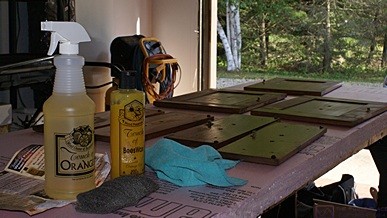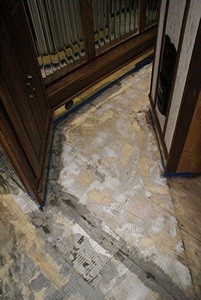We arrived at the SLAARC breakfast just before 8 AM. We took the last two seats at the end of the long row of tables, but had to add another one as six more people came in after us. We had a lively chat that lasted until almost 9:30. After breakfast we stopped at the Tractor Supply Company store in New Hudson to get a couple more deer blocks and then headed for home.
We took a few minutes to put away tools and straighten up the garage enough that we could set up a work surface for Linda to use for cleaning the walnut drawer fronts for all of the bus drawers. We set up the two sawhorses we got at Lowe’s yesterday, set two 8-foot 2x4s in the provided grooves, and set a 4’x8′ piece of 2″ rigid foam insulation across them to use as the work surface. I found an old package of 4/0 steel wool and Linda found some old terry cloth towels.

Foam insulation work surface in garage with walnut drawer fronts laid out for cleaning with Touch of Oranges.
Linda removed the drawer fronts from seven of the drawer boxes and tagged them so they could be reunited later as each front is uniquely paired with its box. She then removed the handles from the drawer fronts and set them aside as they will be replaced with new ones once the cleaning is done. She started with the back sides of the drawer fronts. Following the directions she sprayed them liberally with Touch of Oranges wood cleaner, let them sit for 10 minutes, sprayed them again lightly, and rubbed them with the 4/0 steel wool. She then wiped them off with a terry cloth towel and applied Touch of Beeswax using 4/0 steel wool, always working with the grain, of course. The wax will have at least 24 hours to soak in before being wiped off. Once that is done she will flip them over and repeat the process on the front side.
While Linda was doing all of that I hauled the 15 gallon DeWalt portable air compressor out by the bus, plugged it in, and connected the air hose. I used the 4″ circular pneumatic sander on a few remaining high spots and decided I was done with it. I had found some old packs of 80 grit half sheets and tried using them on my orbital sander but the grit disappeared very quickly and the sheets snagged and tore on splinters in the plywood. I spent more time changing sheets than I did sanding with them so I abandoned this approach after the fifth sheet. I did, however, find a half dozen splintered areas and prepared those by making stop cuts with a utility knife and then peeling the splinter free with a putty knife, creating voids that will be filled with leveling compound.
I was tired of sanding and was clearly not going to get the floor back down to bare wood. I decided that the floor was as sanded and smooth as it was going to get and it was time to move to the next process; patching and leveling. Before I could do that, however, I needed to clean the coach. I vacuumed the floor three times and vacuumed all of the woodwork and wallpaper. As I worked from the bedroom forward Linda followed behind with a microfiber cloth wiping down all of the woodwork.
I assembled the tools I needed to apply the Universal Patch and Skimcoat; a 3″ putty knife, a 5″ putty knife, a combination smooth and toothed rectangular trowel, a mixing bucket, and a 2 foot long wooden stir stick and a mixing paddle designed to go in a drill. Each bag of UPS weighs 7 pounds and gets mixed with 1.75 quarts of water, which works out to 1 part water to 2 parts UPS.
The directions on the bag indicated that a full bag of UPS, properly mixed, would cover 20 to 25 square feet 1/8″ thick. That’s only a 5’x5′ area, but I only had a few gouges that were 1/8″ deep, so an entire bag was going to cover a lot more than 25 square feet when applied as a skim coat. Not having worked with this material before I had no idea how much working time I would have so I decided to mix half a bag. The recommended mixing method using a paddle in an electric drill turned out to be a bad idea so used the 2-foot long wooden stir stick to mix the compound.
I started in the bathroom patching small depressions and then working out from the baseboards. By the time I got out into the hallway I had not even used half the compound and it was starting to set up. I hurried to use as much of it as I could, and tried adding a little extra water to extend its workability, but was only able to use about 60% of it before it was too stiff to spread and trowel off smoothly. I could have waited 1 hour and then mixed and applied more compound but I did not want to risk disturbing what I had already done and it has to set for 24 hours before I can sand it, which I will have to do.
Cleanup required warm soapy water for the tools. I then poured it into the 5 gallon compound bucket, topped it up with water, stirred it to dissolve the compound as much as possible, and let it sit.
For dinner Linda made Farro with mushrooms, onions garlic, glazed snow peas, and grated carrots. She needed some dry white wine for the Farro dish and opened a bottle of Pinot Grigio, so we had a glass with the meal. As rule if a wine is used in a dish it is also a good choice to drink with that meal.
After dinner I went to Lowe’s and got some more 4/0 steel wool and some 80 grit sandpaper sheets. I stopped at O’Reilly’s for a battery disconnect switch for the lawn tractor but they did not have one. I tried the Howell Tractor Supply Company but they did not have one either. I drove to the Brighton Shell station, topped off the fuel in the Element, and went home. We turned in at 9 PM and watched a 007 movie before going to sleep.
